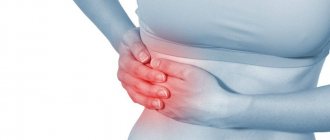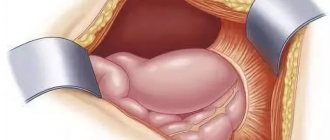Discomfort in the area of the left rib is mistakenly perceived by many as heart problems. But this is far from true. On the left side, under the ribs, there are other internal organs: stomach, gall bladder, pancreas, spleen, kidneys, lungs, diaphragm. That is why it is worth understanding that perhaps the reason is not only in the heart.
If you experience pain in this area, you need to consult a doctor, where you will describe in detail the nature of the pain and other points. After this, the doctor will be able to examine you, diagnose you and prescribe effective treatment. In the article we will talk about which organ can cause pain in the left side under the ribs and what pathologies there may be.
Pain on the left side under the ribs in front
The presence of pain in the region of the ribs on the left side can sometimes become a symptom indicating abnormalities in the functioning of the heart, for example, myocardial infarction, lung damage or diseases associated with the nervous system.
Basically, the cause of pain can be the abdominal organs: the stomach, if an ulcer, gastritis or other neoplasms have formed in it. The nature of the pain in this case is acute and radiates to the right. Sometimes the pain can be constant and not associated with eating.
In most cases, in addition to pain, other symptoms may be present: heaviness after eating, nausea, heartburn, vomiting, belching, bloating, sour taste or burning in the mouth.
Therapy methods
Treatment of pain in the hypochondrium should take into account the pathology that caused it. The use of painkillers will relieve the unpleasant symptom, but will not eliminate the problem.
Treatment of pain syndrome is carried out using the following medications:
- Enterosorbents. Used to eliminate toxins from the intestines that interfere with its functioning.
- Antibiotics. Used in the development of infectious diseases.
- Enzyme agents. Used if there are problems with the functioning of the pancreas.
- Enveloping agents. Prescribed for the development of gastritis or peptic ulcer.
- Uroseptics. Used to destroy infections in the urinary system.
For heart diseases, beta blockers, diuretics, calcium channel blockers, and aspirin are used. For pathologies of the reproductive system in women or in the presence of serious problems with the spleen, surgical treatment is often used.
Pain on the left side under the ribs
If you feel pain in the left hypochondrium on the side, then you may have problems with the nerves. The nature of the pain can be described as the passage of current, the network is sharp and short from the spine to the chest. Occurs due to the position of the body in an awkward position, physical activity. Other symptoms may include migraines or seizures. Another possible reason may be the presence of herpes zoster. In this case, pain first increases on the left side, and then rashes appear.
Preventive measures
To prevent problems with the functioning of the gastrointestinal tract, it is important to adhere to a special diet - eat small portions, but often, and avoid overeating. The daily diet should consist of vegetables, fruits, dietary meats and fish, and cereals. You should avoid fried, fatty and smoked foods.
Disease prevention also involves leading a healthy lifestyle. You need to move a lot and play sports. Preventive examinations with a therapist and other highly specialized specialists will help prevent the development of serious pathological conditions. You need to visit doctors and get tested annually, regardless of how you feel.
Pain under the ribs on the lower left
Pain below the left ribs indicates that the spleen has increased in size. This condition can be provoked by the presence of infectious diseases:
- infectious mononucleosis, accompanied by fever, sore throat, and enlarged lymph nodes.
- hemoblastic diseases: lymphomas, leukemia, chronic lymphocytic leukemia.
- septic diseases: purulent abscesses, bacterial endocarditis.
- chronic diseases with a high degree of severity: tuberculosis, lupus erythematosus, malaria.
An enlarged spleen or splenomegaly is a very dangerous symptom, since the slightest wrong movement can lead to its rupture. After which you will feel severe pain in the left hypochondrium and may faint. Then there comes a moment of calm, no pain for up to three weeks. Then the sharp pain returns.
Aching
An aching burning sensation in the left side under the ribs in front most often indicates gastrointestinal pathologies:
- duodenitis;
- gastritis;
- stomach ulcer.
Painful sensations are accompanied by nausea and vomiting.
In some cases, an aching burning sensation may be a sign of angina or incipient myocardial infarction.
Causes of the disease that leads to pain in the left hypochondrium
In addition to the above reasons, pain in the left hypochondrium can be caused by:
- Acute and chronic pancreatitis occurs due to alcohol abuse, overeating, gallstones, viral infections, and abdominal trauma. The pain is unbearable, sharp, under the left rib, which is accompanied by severe vomiting and radiates to the shoulder and back.
- A tumor of the pancreas is a consequence of obesity, excessive physical exertion during physical activity, pregnancy or in the elderly.
- Lung diseases (for example, lobar pneumonia) are characterized by a dull pain that becomes stronger during coughing, headache and muscle pain, fever, weakness, a feeling of heaviness, constipation and sweating, mucus and sputum.
- Improper fixation of the splenic angle of the colon, or Payr's Syndrome, causes chronic pain in the left hypochondrium. The sensations may intensify and radiate to the lower back and cardiac region. Symptoms most often occur after eating or during intense physical activity. Constipation may also be present for 3-5 weeks;
- Injuries and fractures that can lead to pain and injuries to internal organs.
- Rheumatism, radiculitis, thoracic osteochondrosis.
- Splenic rupture.
- Female genital organs (pain during the menstrual cycle or enlarged uterus during pregnancy).
Dumb
Dull pain in the left side is most often associated with gastrointestinal diseases:
- pancreatitis;
- chronic gastritis.
Cholecystitis may also be accompanied by a dull left-sided burning sensation. In this case, the main focus of pain is localized in the right hypochondrium, but unpleasant sensations can radiate to the left side.
A burning sensation in the left side can also occur with infectious pathologies. The spleen is located in this area of the body. It is an immune organ. If a person is sick with a bacterial or viral infection, the spleen has to work under increased load. For this reason, pain occurs in the left side of the hypochondrium.
Treatment of diseases
As soon as you feel pain, you should immediately contact a specialist. At the hospital, doctors will conduct an examination and take an anamnesis using the prescribed comprehensive laboratory and diagnostic methods (ultrasound, radiography (X-ray), MRI if necessary). Further, based on the research results, the doctor will give the patient the necessary methods of therapy and treatment or issue a referral for additional diagnostics to a doctor of another specialization (for example, an endocrinologist, gastroenterologist, urologist or gynecologist). It is necessary to follow all the doctor’s recommendations: nutrition protocol and medication.
Treatment methods are usually aimed at eliminating the symptoms, after which the pain in the hypochondrium goes away. If the pain is unbearable, then narcotic analgesics are prescribed, and sometimes novocaine blockades are made. Etiopathogenetic drug therapy includes: enzymes, probiotics, antisecretory drugs, antibiotics, inhibitors, non-steroidal anti-inflammatory drugs.
For pain in the left hypochondrium caused by Payr's syndrome, it is better to prescribe physical therapy: electrophoresis with local anesthetics, iontophoresis with proserin, UHF therapy, diathermy, reflexology, magnetic therapy.
Heart diseases
A burning sensation in the left side under the ribs in front is often caused by heart pathologies. This is the most dangerous cause of discomfort. After all, diseases of the heart and blood vessels often lead to serious consequences.
The following pathologies may be accompanied by a burning sensation in the left lateral area:
- Cardiac ischemia. The cause of this disease is a violation of the blood supply to the heart muscle due to atherosclerosis. The pathology manifests itself in periodic attacks of heart pain (angina), which is accompanied by a feeling of constriction in the chest. The pain syndrome is relieved by taking vasodilator drugs.
- Myocardial infarction. This dangerous condition develops as a complication of ischemia. The blood supply to the myocardium is so severely disrupted that necrotic lesions form on the heart muscle. An early sign of a heart attack may be a burning sensation in the left side of the chest or in the hypochondrium. Then severe pain syndrome develops, which is not relieved by taking vasodilator drugs. The patient needs immediate hospitalization, otherwise a heart attack can lead to death.
- Cardiopathy. With this disease, the myocardium undergoes dystrophic changes. Burning and pain are accompanied by irregular heart rhythms and weakness. This disease is secondary in nature and is a consequence of infections, hormonal imbalances, and metabolic disorders. Therefore, it is necessary to treat the underlying disease.
It is important to remember that myocardial infarction can occur in an atypical form. Its manifestations may resemble the symptoms of gastritis or stomach ulcers. Only a doctor can make a differential diagnosis. In any case, if there is severe pain on the left side of the body, you must call an ambulance.
Disease Prevention
From our article we can conclude that there are many reasons that can cause pain and discomfort in the left hypochondrium. Thus, the only thing we can do is to give recommendations that reduce the risk of recurrence of diseases:
- If you experience pain in the left side and the first symptoms, you should consult a doctor, especially if the pain does not go away for a long time and becomes more intense;
- If possible, undergo a full medical examination once a year. This will help to identify the first signs of the development of pathology in the early stages and other disorders of the body, which will simplify and significantly reduce the cost of their treatment;
- After completing the main course of treatment, strictly follow the recommendations of your doctor to avoid recurrence of the disease and unpleasant complications.
Acute
A burning sensation in the left side under the ribs, quickly developing into acute pain, is most often observed with injuries. Unpleasant sensations intensify when inhaling. This is a rather dangerous symptom that indicates damage to internal organs.
It is important to remember that rib fractures often occur during falls. In this case, bone fragments can damage the lungs.
In this case, you cannot hesitate for more than a minute. It is necessary to consult a doctor as soon as possible. Otherwise, internal bleeding may develop.
Splenic rupture
This is an organ located in the hypochondrium on the left side. The spleen is a kind of storage facility for red blood cells. It is involved in immune processes and is involved in cleansing liquid connective tissue from harmful substances.
When the spleen ruptures, a stabbing pain occurs when inhaling on the left side under the ribs. The abdominal cavity is damaged and blood leaks into it. Against this background, the pain when inhaling on the left under the ribs on the side increases significantly. Over time, it covers the entire abdomen. It becomes extremely difficult for a person to swallow air.
In addition to pain when inhaling under the rib on the left, the following symptoms are observed:
- cyanosis of the skin in the area where the spleen is located;
- chills;
- nausea turning into vomiting;
- high body temperature;
- arterial hypotension.
If there are signs of organ rupture, you must immediately call an ambulance. But even with timely intervention by doctors, the spleen can be saved only in 1% of cases. Therefore, the main treatment for this condition is complete removal of the organ.
Gynecological pathologies
A burning sensation in the left side of women is often a sign of genital diseases:
- Endometriosis. This disease is expressed in pathological growth of the inner layer of the uterus. Most often it is associated with hormonal imbalances. The pain syndrome intensifies on critical days. During the intermenstrual period, brown discharge comes out of the genitals. This disease requires complex treatment. Prescribe hormonal drugs, antibiotics, immunomodulators.
- Rupture of the fallopian tube. This is a serious and life-threatening condition. The pain syndrome may begin with a burning sensation in the left side of the lower abdomen. Subsequently, acute unbearable pain occurs. The woman experiences severe weakness and pale skin. Blood pressure drops to critical levels. In this case, emergency surgical intervention is required, otherwise the patient may die.
- Inflammation of the uterine appendages (adnexitis). At the beginning of the disease, a slight burning sensation occurs. Then it turns into a constant aching pain, radiating to the groin area. Malaise and fever occur. This pathology is dangerous due to its consequences. Advanced inflammation of the appendages threatens tubal obstruction and the development of infertility. Therefore, if you have such symptoms, you should visit a gynecologist as soon as possible. Adnexitis is treated with antibacterial drugs.
- Ectopic pregnancy. If the embryo develops not in the uterus, but in the left tube, then this is accompanied by severe pain. Signs of an ectopic pregnancy are usually observed at 4-6 weeks of gestation. At earlier stages, serious discomfort in the abdominal area and a burning sensation in the left side may be felt. In this case, the patient needs emergency hospitalization and surgery. Without timely surgical intervention, such a pathology of pregnancy inevitably leads to rupture of the fallopian tube.
It should be noted that a burning sensation in the left hypochondrium can also be observed during normal pregnancy in the later stages. This is due to the fact that the uterus greatly increases in size and puts pressure on the internal organs. In this case, burning is considered normal and does not indicate pathology.
Diagnostics
The choice of the necessary diagnostic method depends on the suspected disease. The doctor may order the following tests:
- clinical and biochemical blood and urine tests;
- stool test for bacteria;
- gastroscopy;
- colonoscopy;
- Ultrasound of internal organs;
- ECG;
- magnetic resonance imaging.
Gastrointestinal pathologies
Gastritis and stomach ulcers may be accompanied by a burning sensation on the left side of the abdomen. The pain usually intensifies with long breaks between meals and is accompanied by nausea, vomiting and heartburn. Treatment of gastritis depends on its form. When acidity is high, antacids are prescribed, and when acidity is low, enzymatic preparations are prescribed. A strict diet is recommended. Stomach ulcers require antibiotics, antihistamines, and proton pump blockers.
The cause of the burning sensation may be pancreatitis. When the patient's pancreas becomes inflamed, the production of enzymes decreases and the digestion process is disrupted. Burning sensations on the left turn into girdle pain. In this case, nausea, fever, and malaise are noted. The patient is advised to follow a special diet, as well as take enzymes and antibiotics.
The sigmoid colon is located on the left side of the abdominal cavity. Inflammation of this organ (sigmoiditis) may be accompanied by a burning sensation. The pain intensifies before defecation and when walking. The patient has diarrhea, stool looks like meat slop and has an unpleasant odor. Sigmoiditis is usually a consequence of other gastrointestinal diseases. You can get rid of this pathology only by curing the underlying ailment.
A burning sensation that turns into cramping pain may be one of the first signs of dysentery. This infectious disease is caused by bacteria called Shigella. The patient's health sharply worsens, nausea, general malaise, and severe diarrhea mixed with blood (stools up to 10 times a day) occur. Often there are false painful urges to defecate. The patient must undergo a course of antibacterial therapy, otherwise dysentery may become chronic.










